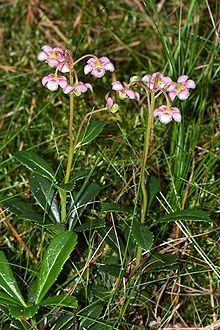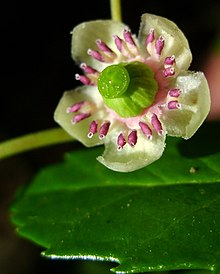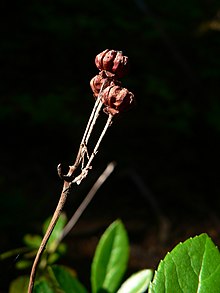Chimaphila umbellata
| Chimaphila umbellata | |
|---|---|

| |
| Scientific classification | |
| Kingdom: | Plantae |
| Clade: | Tracheophytes |
| Clade: | Angiosperms |
| Clade: | Eudicots |
| Clade: | Asterids |
| Order: | Ericales |
| Family: | Ericaceae |
| Genus: | Chimaphila |
| Species: | C. umbellata
|
| Binomial name | |
| Chimaphila umbellata | |
Chimaphila umbellata, the umbellate wintergreen, pipsissewa, or prince's pine, is a small perennial flowering plant found in dry woodlands, or sandy soils. It is native throughout the cool temperate Northern Hemisphere.
It grows 10–35 cm tall, and has evergreen shiny, bright green, toothed leaves arranged in opposite pairs or whorls of 3–4 along the stem. Leaves have a shallowly toothed margin, where the teeth have fine hairs at their ends. The flowers are white or pink, produced in a small umbel of 4–8 together.
Ecology[]

Although it has green leaves year-round, it receives a significant portion of its nutrition from fungi in the soil (that is, it is a partial myco-heterotroph, which is not surprising as related plants, such as Pyrola, are partial or full myco-heterotrophs).[1]
Taxonomy[]

There are four subspecies:
- Chimaphila umbellata subsp. umbellata – Europe, Asia
- Chimaphila umbellata subsp. acuta – southwestern North America
- Chimaphila umbellata subsp. cisatlantica – northeastern North America
- Chimaphila umbellata subsp. occidentalis – northwestern North America
Uses[]
Some Plateau Indian tribes used a boil of prince's pine to treat tuberculosis.[2]
The twentieth century Appalachian folk healer Clarence "Catfish" Gray, "Man of the Woods", credited pipsissewa with curing his own heart problems and included it in his 15 herb cure-all "bitters."[3]
It is used as a flavoring in candy and soft drinks, particularly root beer.
The roots and leaves of Chimaphila umbellata can be boiled to create tea.[4]
Recent investigations show the anti-proliferative effect of Chimaphila umbellata in human breast cancer cells (MCF-7). [5]
Name[]
"Pipsissewa" is a Cree name meaning "It-breaks-into-small-pieces".
| Wikimedia Commons has media related to Chimaphila umbellata. |
References[]
- ^ Leho Tedersoo; Prune Pellet; Urmas Kõljalg; Marc-André Selosse (March 2007). "Parallel evolutionary paths to mycoheterotrophy in understorey Ericaceae and Orchidaceae: ecological evidence for mixotrophy in Pyroleae". Oecologia. 151 (2): 206–217. Bibcode:2007Oecol.151..206T. doi:10.1007/s00442-006-0581-2. PMID 17089139. S2CID 12529846.
- ^ Hunn, Eugene S. (1990). Nch'i-Wana, "The Big River": Mid-Columbia Indians and Their Land. University of Washington Press. p. 352. ISBN 978-0-295-97119-3.
- ^ Green, E. (1978). "A Modern Appalachian Folk Healer". Appalachian Journal. 6 (1): 2–15.
- ^ Patterson, Patricia A. (1985). Field Guide to the Forest Plants of Northern Idaho (PDF). United States Department of Agriculture Forest Service. p. 37-47.
- ^ Das, N., Samantaray, S., Ghosh, C., Kushwaha, K., Sircar, D. and Roy, P., 2021. Chimaphila umbellata extract exerts anti-proliferative effect on human breast cancer cells via RIP1K/RIP3K-mediated necroptosis. Phytomedicine Plus, p.100159.
External links[]
- NatureServe secure species
- Chimaphila
- Flora of North America
- Flora of Europe
- Flora of Asia
- Plants used in traditional Native American medicine
- Medicinal plants of Asia
- Medicinal plants of Europe
- Plants described in 1753
- Rhizomatous plants
- Stoloniferous plants
- Taxa named by Carl Linnaeus
